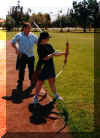


Longbows | Slings & Staff Slings | Crossbows
Bows have been around for thousands of years. Although the origin of the bow is unknown, it is known that it was use throughout the world by 8000 BC.
There are many types of bows in use. The simple bows are made from a stave of springy wood of which one end has a strong cord that is permanently attached. The other end is made into a loop and can be notched into place by bending the bow and placing the looped end of the cord into the notch at the end.
The arrows for the bows are made from long straight wood with a notch at one end which allows the bowstring to fit it, with a heard at the other end which can be a fire-hardened tip right through to elaborately carved arrow tips made of stone, bone, ivory, petrified wood, jade or metal.
Stability for the arrow is provided by fletching the arrow with 'flights' at the end with the notch. They are usually feathers of two, three or four arranged in a symmetrical pattern around the arrow and are attached by gluing or binding them.
The longbow can be fired with accuracy to about 200 yards (183 metres) with a maximum range of about 250 yards (229 metres). Bows which are laminated can fire up to twice the distance of the conventional bow.
The pictures below are of people shooting arrows at targets (Pictures 1 & 2) and the second two pictures are of me and another SCA member doing combat archery with blank arrows and myself dressed in Chain Mail armour ready for
Archery Shot 1 | Archery Shot 2 | Archery Shot 3 - combat archery
Combat Archer (me)
The sling was one of the first throwing weapons to be used man. The purpose of the sling is to fit a small round object like a stone into a pouch at the end of two cords and to swing it around to pick up speed and momentum and at the optimum point in the slings rotation, release one of the strings and the object flies out.
The art of using slings is in determining where to release the string and let the object go out as the direction and the range of the object flung out depends on this.
There are many variations of the sling and one interesting but uncommon variant was the 'Fustibal' or as it is better known, 'Staff Sling'.
The Staff sling's origins are not known but there is evidence that the Romans were using it in combat in the 3rd century BC. The staff sling extends the throwers arm increasing the radius of the slings travel with improved velocity and range but at a cost of increasing the skills needed to effectively use it. The main advantage is that it could be used in a group of men by swinging it overhead rather than the side as required by most conventional slings.
Crossbows first appeared in China around 500 BC. Its introduction into Europe is somewhat of a mystery with the Byzantines, Saracens and the Hans all possibly responsible. However the military impact was minimal until the 11th century when the crossbow was used by France in combat.
The design of a crossbow is a simple 'conventional bow' which is mounted on a shoulder stock, but the mechanising of the crossbow made it an exceptionally powerful weapon. Starting with the conventional wood bow design, crossbows soon used compound bows of horn, sinew and wood which needed mechanical assistance in drawing the string back.
Once the string was drawn back it was held by a catch and a bolt or 'quarrel' (from the French word carreau - the square section of the tip) was laid in a groove in the stock and the crossbow was aimed and fired.
Pressing the trigger released the string and the compound bow was released with enough strength for the quarrel travelling at high speed to pierce chain mail armour at 100 yards (92 metres) distance.
The more powerful crossbows had a mechanical aid in winding the string back ready for another shot. The crossbow man would put his foot in a stirrup at the head of the crossbow to provide leverage to wind the string back.
The powerful crossbow was capable of firing a quarrel up to 370 yards (405 metres) which easily outdistanced the conventional longbow.
The only drawback was that a bowman could get off six well aimed shots with his bow compared to 1 or even 2 shots with a crossbow in a minute.
This picture below is of one of the SCA members who enjoys combat archery with the crossbow
Combat Archery - crossbow
For further information on these and other weapons and armour described here in these web pages, see my bibliography page.
Click on the Back icon to return to the Weapons page